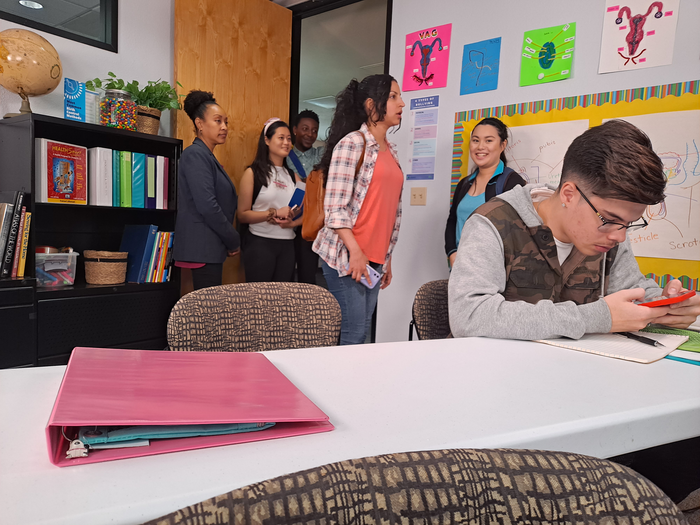Can a school-based sexual health education program that effectively reduces the risk of unintended pregnancy and STIs also decrease homophobia and transphobia?

Credit: credit: dfusion inc.
Can a school-based sexual health education program that effectively reduces the risk of unintended pregnancy and STIs also decrease homophobia and transphobia?
That question drove a collaborative effort by researchers conducting a randomized controlled trial of an inclusive comprehensive sex education program – High School FLASH. The study evaluated not just the impact on students’ sexual behaviors and related outcomes but also on their homophobic and transphobic beliefs (Coyle et al., 2021). With funding from the U.S. Department of Health and Human Services, researchers evaluated High School FLASH in 20 schools in two U.S. regions (Midwest and South). Study findings related to the curriculum’s impact on homophobic and transphobic beliefs are described in this new 2023 article in Prevention Science (Kesler et al. 2023).
The issues. Young LGBTQ students often endure homophobic and transphobic language at school, experiencing victimization and discrimination based on their sexual orientation and/or gender identity. These students can experience both negative academic consequences (e.g., lower grades, absenteeism, disconnection from school communities) as well as mental health consequences, including depression, anxiety, and lowered self-esteem.
Schools have a critical role to play in combatting discrimination and transphobic violence for LGBTQ students and improving their academic, health and well-being. Along with anti-bullying policies and sponsoring GSA organizations, schools can contribute to safe and affirming environments for all by offering inclusive curricula. Research has shown that LGBTQ students who received inclusive sexual health curricula experienced lower levels of victimization, increased feelings of safety at school, fewer safety-related school absences, better academic performance, and increased feelings of connection to peers.
Inclusivity goal and challenges. Even sexual health curricula that claim to be inclusive do not always affirm all young people’s identities and orientations. Some of the issues identified by LGBTQ youth as contributing to the lack of positive representation in their health curricula include: silences on the part of the teacher or the curriculum about LGBTQ issues/individuals, heterosexist framing of the information presented, and the ongoing pathologizing of LGBTQ individuals or specific sexual practices.
BA Laris, one of the study’s authors, notes that “there is really little to no guidance on how to make a curriculum inclusive.” She observes that quick fixes aren’t the answer. “People will often say ‘just add LGBTQ characters’ or ‘make names gender neutral in scenarios’, but that is not enough and there is no systematic guidance on how to do it.”
Enter the FLASH program strategy. FLASH uses a very systematic process to imbue the whole curriculum to be inclusive. In addition to creating a lesson focusing specifically on sexual orientation and gender identity, all of the FLASH lessons:
- Provide visibility, depicting young people with a variety of sexual orientations and genders and in diverse contexts (e.g., sexually active, abstinent, partnered, single)
- Normalize a wide range of identities
- Portray LGBTQ young people in a variety of situations, including caring, satisfying, healthy relationships
- Use a nuanced approach to inclusive language, striking a strategic balance between broad inclusion (e.g., the use of neutral language such as “partner” that allows a single sentence or concept to be relevant to a large group) and visibility of specific identities (using specific language such as “boyfriend” or “girlfriend”)
- Ensure relevance of content to all. For example, the birth control lesson in High School FLASH starts with the statement “this lesson is for everybody—people who are having vaginal sex now or who will in the future, and teens of all sexual orientations and genders. Even if someone won’t ever need birth control, learning about it now will help them act as health educators for their friends and families on this important topic. Additional inclusivity strategies included in the development of FLASH: a) instructing teachers to use a specially designed protocol to affirm identities in class discussions, when answering questions, along all domains of identity (e.g., sexual orientation, gender, ability, religion, race, ethnicity); b) testing of all curricular messaging with a diverse group of young people, with LGBTQ youth purposefully overrepresented; c) content adjustments according to feedback and re-testing until acceptability was reached; and d) multiple piloting efforts of lessons in public school classrooms to gauge understandability.
Did it work? In the study, 20 schools drawn from 7 districts in two regions of the South and Midwest were randomly assigned to receive FLASH or a comparison curriculum. A total of 1597 9th and 10th grade students took part in the baseline survey (831 intervention and 766 comparison), representing 92% of the students who had positive parent consent and were eligible for the primary study. Students completed follow-up surveys 3 and 12 months after the instructional period. Researchers examined changes in homophobic beliefs among straight cisgender young people versus those who identified as not straight or cisgender. FLASH’s positive impact on reducing homophobic and transphobic beliefs was statistically significant for both straight and cisgender youth at both 3- and 12-month follow up timepoints (p<0.01, n=1144 and p+0.05, n+1078, respectively.) For a full study description, see Coyle et al (2021).
As Laris emphasizes, “what this study showed is that the process is effective because all students (both LGBTQ participants and straight and cisgender participants) decreased their homophobic beliefs.” This has different and important implications for each group. A reduction in homophobic and transphobic beliefs among LGBTQ students signals an improvement in how one feels about themselves (a decrease in internalized homophobia and transphobia). The reduction in homophobic and transphobic beliefs among straight and cisgender students reflects an improvement in how one perceives LGBTQ peers, potentially leading to a reduction in harassment and an improved school climate.
The encouraging take-away here? FLASH is the first evidence-based teen pregnancy prevention program to date to report findings showing it reduces prejudice against people who are LGBTQ.
________________________________________________________
Research team/authors and affiliations:
Kai Kesler and Andrea Gerber (Public Health—Seattle and King County, Seattle WA)
BA Laris (dfusion Inc, Scotts Valley CA) www.dfusioninc.com
Pamela Anderson and Karin Coyle (ETR, Scotts Valley, CA) www.etr.com
Elizabeth Baumler (University of Texas Medical Branch Galveston, Galveston TX)
Citations:
Kesler, K., Gerber, A., Laris, B. et al. High School FLASH Sexual Health Education Curriculum: LGBTQ Inclusivity Strategies Reduce Homophobia and Transphobia. Prev Sci (2023). https://doi.org/10.1007/s11121-023-01517-1.
Coyle, K., Anderson, P., Laris, B. A., Barrett, M., Unti, T., & Baumler, E. (2021). A group randomized trial evaluating high school FLASH, a comprehensive sexual health curriculum. Journal of Adolescent Health, 68(4), 686–695. https://doi.org/10.1016/j.jadohealth.2020.12.005
Journal
Prevention Science
DOI
10.1007/s11121-023-01517-1
Method of Research
Randomized controlled/clinical trial
Subject of Research
People
Article Title
High School FLASH Sexual Health Education Curriculum: LGBTQ Inclusivity Strategies Reduce Homophobia and Transphobia
Article Publication Date
17-Mar-2023




